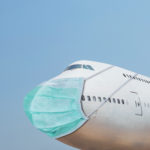FINN editor-in-chief Alan Peaford looks at how the role of drones has been pushed to the forefront during the coronavirus pandemic.
There are few sectors that could be said to have benefited from the COVID-19 pandemic which has swept across the world and with it, damaged the whole aerospace industry.
But on the Isle of Wight, an island off the coast of southern England, an electric whine above the beaches and fields of the popular vacation spot, is one area that has. The whine comes from an unmanned air vehicle developed by the University of Southampton and crossing what only three or four months earlier was a busy piece of controlled UK airspace with tight air corridors where pleasure-seeking GA pilots dodge the Class A airspace from traffic approaching Southampton and Bournemouth Airports.
COVID-19 put a stop to all that. GA and airlines were grounded. Air space was simply that, a spacious air corridor untroubled by mankind. But from every crisis there is an opportunity.
Medical supplies drone service is first of its kind in UK
A decision was taken to trial a drone service for delivering urgent medical supplies to the island in response to the COVID-19 outbreak. Following the example of Zipline in Africa, the trial, which is funded by the Department for Transport and led by Solent Transport, is the first of its kind in the UK and aims to benefit patients by speeding up the delivery of medical supplies.
The mission, taking up to 100kg payload of medical supplies to St Mary’s Hospital in Newport from the mainland, via Solent Airport, takes just 10 minutes – way faster than the traditional ferry and much cheaper than a helicopter.
A special air corridor has been developed and something that pre-pandemic would have taken years to get approved, has taken just months to come to fruition.
Solent Transport is also looking to develop an air traffic management system to oversee the safe movement of both manned and unmanned aircraft in shared airspace and now different unmanned vehicles are being trialled to see how they could improve the movement of medical supplies.
Enabling vital medical deliveries in Rwanda
In Rwanda, this is old hat. Since 2016, the African nation has opened its doors to an American start-up to work together on integrating drones into its airspace. The Californian business, frustrated with barriers in its home market, upped sticks to the land of a thousand hills. The result has been little short of miraculous and has spread across the continent to Ghana on the West coast – and during the crisis, the company has been looking at delivering services in the US.
In Africa, the company has engineered its drones to carry desperately needed blood, vaccines, and medical supplies to rural medical centres crossing terrain that would take hours to cross by road and vitally, in these days of social distancing, without any direct human interaction.
Having started as an operation delivering blood, Zipline now serves 2,500 hospitals in Africa delivering medical supplies such as PPE on demand.
The FAA has awarded $2.6 million in grants to universities partnered with the agency, with funds dedicated to researching ways in which drones can be safely integrated into US airspace. But the pandemic has proved to be an ideal catalyst, allowing disruptive technologies to demonstrate their ability to provide speedy, socially distanced, solutions.
Life changing applications are being identified
Over the past five years, interest in drones has grown from something to be feared or loathed into something that could change our lives.
Deloitte’s Chris Metts said: “We’re seeing growing potential for the application of drones, from disaster management to deliveries, search and rescue and more.”
“I believe in many ways that the best and most appropriate use of drones is the niche uses that everybody is coming up with. These are things that support their organisations to save money and time, and they need to be able to pursue those in order for their businesses to continue to thrive. What is necessary, though, to facilitate that, are some infrastructural or foundational issues that allow us to bring those niche drone solutions to market.”
Training is one of these issues. Sweden’s UMS Skeldar has been developing military drones but is now offering civil applications. The company is working on training system to enable users to get the most of the platforms.
Surveillance is one of the key advantages of unmanned air vehicles and is proving popular with police for monitoring crowds and trouble hot-spots. Mind you, police in Connecticut took this a step too far. They introduced a drone to monitor social distancing and detect whether people have coronavirus symptoms, such as fever or coughing.
They had been looking for effective ways to monitor social distancing, ease the spread of COVID-19 and keep their communities and personnel safe, but concerns were raised about privacy, efficacy, and the overall need for such a solution. Following a public protest over privacy, the ‘Flatten the Curve Pilot Programme’ was withdrawn.
Wing delivers meal packages to vulnerable people
Where Amazon has been promising home drone deliveries for some time amid much public scepticism, one company in America has succeeded. Wing, which is part of Google, took an opportunity from COVID-19 to begin delivery of packages – including meals – to homes in Virginia as part of an FAA funded programme. The company became the first drone operator to be formally certified as an air carrier by the FAA, which gave it the right to proclaim itself the only authorised residential drone delivery service in America. The local population has become used to the sight of a Wing drone dropping in its delivery from the local Walmart.
“Even we were surprised at the uptake of customers when ‘shelter-at-home’ came to Virginia,” said Wing’s Alexa Dennett. “When people are homebound and need to limit human-to-human contact, our drones enable people to maintain a sense of normalcy without needing to travel or interact with one another. This is great news for communities trying to practice good social distancing during the pandemic. In contrast, it’s much more difficult for human delivery drivers to keep their distance.”
Disinfectant spraying will help restore confidence to Broadway Theatres
Drones will also help in restoring the old world and shaping the new normal. As Broadway executives debate different strategies for reopening theatres, EagleHawk, a New York start-up has developed drones to spray disinfectants in Broadway theatres. “This technology reduces the need for human exposure, minimizes the costs of PPE and can save a great deal of time and resources,” commented said Will Schulmeister, its chief operating officer.
In Abu Dhabi, the New York University (NYU) campus has teamed up with Abu Dhabi Airports to develop a drone with a robotic arm that can inspect and work on inaccessible areas, for example the roof space on the new Midfield Terminal which towers more than 50 metres high.
This is a world first – the drone can take measurements or observe smells. It can detect cracks and can clean, as Professor Tony Tzes, who heads the project, explains. The drone will not only reduce health risks but will also save money. Work on integrating the project was halted as the coronavirus spread as social distancing and lockdown was introduced. To help students, Professor Tzes switched the drones to deliver groceries to halls of residence.
Drones becoming a greater part of daily life
In France, drones were used in the Fontainebleau forest to enforce measures that restrict people from going out during the night time. Drones were equipped with sensors to detect humans out and about.
Drones are and will become more and more part of our daily life. Police are using them, engineers use them for inspection of the infrastructure; ports, and ships entering them, are also being monitored.
The new normal will undoubtedly have the unmanned drone at its centre – thanks to one small virus particle.

